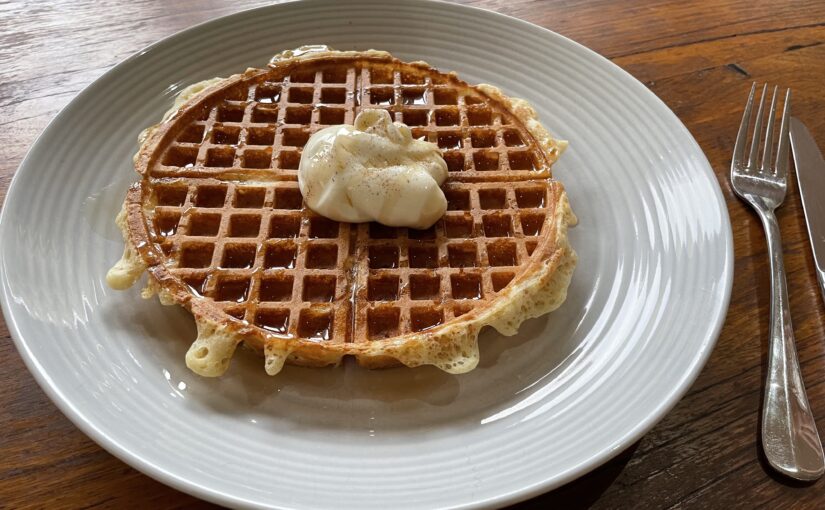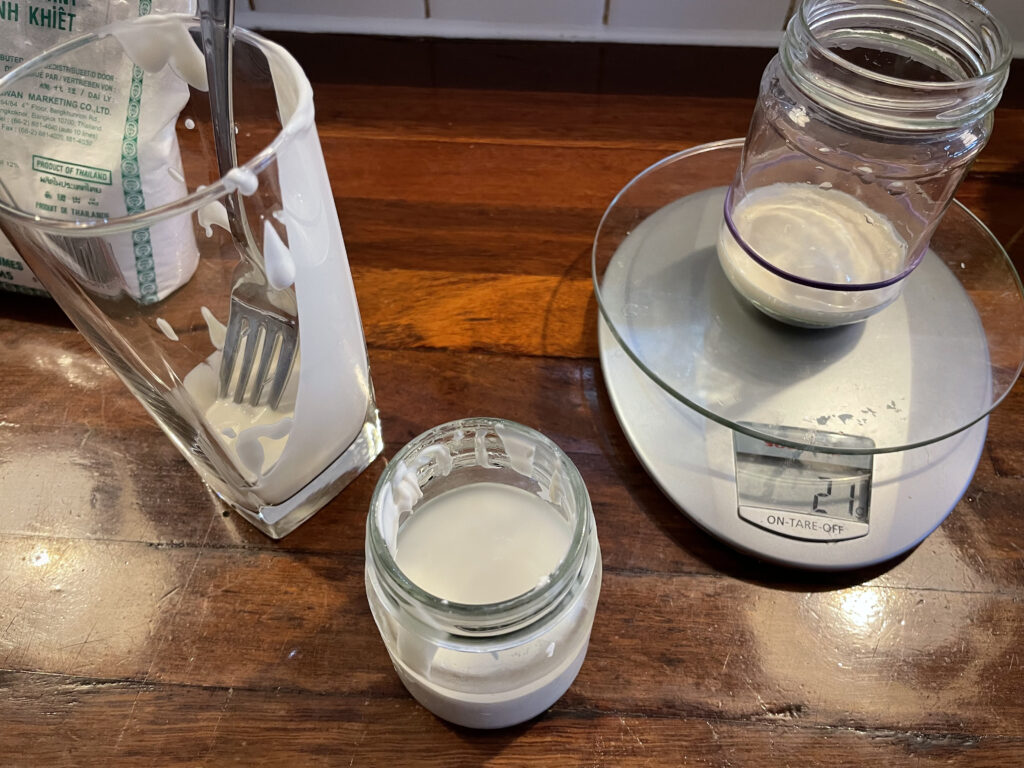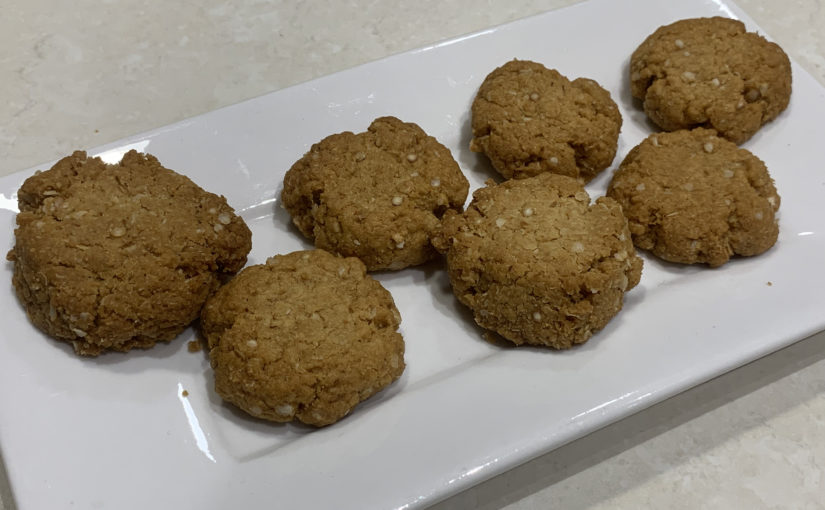Just before Melbourne went into Covid-related lockdown for the fifth time, I joined a gluten-free sourdough bread-making class at a nearby cafe. Their chef, Dom Marzano, shared tips on how to bake a tasty, white, gluten-free sourdough loaf just like they sell in the cafe. I found that their recipe worked just as well with my sourdough starter – a revelation! The secret to achieving a great loaf was not to use a special sourdough starter, but simply use the right flour mix. In this case, the flour mix is the Well & Good Crusty Bread Mix, which sells for about $6 for a 410g pack.
Many gluten-free sourdough bread recipes that I’ve come across require a few exotic flours, so $6 to bake a loaf is reasonable. The Well & Good flour mix magic seems to come from its particular combination of thickeners, which include usual suspects like xanthan gum, guar gum and psyllium husk, plus some others. They’ve done the science to figure out how to make gluten free flours behave like wheat flour, and now I don’t have to.
I maintain a sourdough starter at just 60g, so the recipe below starts from this basis and explains how to build it up and then turn it into a loaf of bread over four days, ready to eat on the morning of the fifth day. It slices up pretty well, so I would say it’s worth the wait!

In the instructions below, I use normal Melbourne tap water (not any warmer than a tepid temperature). If you’re in another region, you may prefer to use bottled water, or boil and then cool tap water instead. Also, I use a half-half mix of brown rice and glutinous rice flour to bulk up the starter to the right amount to bake a loaf, but you can use whatever you’ve been feeding your starter, or even the same Well & Good Crusty Bread mix to keep it simple (if you have extra).
Ingredients – Day 1
- 60g of sourdough starter (from the fridge)
- 45mL (at least) water
- 45g flour (half-half brown rice flour and glutinous rice flour)
Method – Day 1
- Get the sourdough starter out of the fridge at the start of the day, and leave somewhere warm like the kitchen. Wait a few hours until it has warmed up and is looking bubbly.
- Follow the process previously described in the sourdough starter post under the feeding regime, but instead of discarding the remaining starter into the discard jar that’s kept in the fridge, put it in its own small container.
- Follow the feeding regime for the starter that is in this small container, but scaled appropriately to the amount that is in there. Assuming 25g of starter has gone into the small container, add 25g of water and 25g of flour. There should be no left over starter to go into the discard jar. You will now have both the starter jar and the small container with similar amounts of sourdough starter in it.
- Wait a few hours for the starter in the starter jar to have very tiny bubbles, and put it back into the fridge. However, do not put the small container into the fridge – leave it out on the bench or wherever you had it before. It doesn’t matter if it gets cold overnight.
Ingredients – Day 2
- 70g of starter from Day 1
- 70mL (at least) water
- 70g flour (half-half brown rice flour and glutinous rice flour)
Method – Day 2
- About 24 hours after the starter was put into the small container (perhaps around midday), it should look bubbly and is ready to do the feeding regime again, which will triple its weight. Scrape the starter into a medium container, and weigh it.
- Follow the feeding regime again for the starter that is in this container, but scaled appropriately to the amount that is in there. Assuming 70g of starter has gone into the medium container, add 70g of water and 70g of flour. Again, there is no discard.
- Leave the medium container out on the kitchen bench or somewhere warm.
Ingredients – Day 3
- 200g of starter from Day 2
- 300mL water
- 400g Well & Good Crusty Bread mix (or equivalent speciality bread flour)
- 20mL olive oil
- 5g table salt
- fine rice flour for dusting
Method – Day 3
- About 24 hours after the starter was put into the medium container (perhaps around midday), it should look bubbly and is ready. Prepare a banneton, or proofing basket, by dusting with fine rice flour and knocking it around to ensure it is even. If you don’t have a banneton, you can use a ricotta basket or even a plastic colander (if the holes are big, you can also put a cotton tea towel in it first).
- Scrape it into a mixing bowl, along with all the other ingredients, and mix with a dough hook. You can also use a spoon and/or your hands, but that will be a bit messier. Unlike with a gluten-based dough, you don’t need to mix and pound it for ages. After 2 or 3 minutes, it should have been combined together sufficiently.
- Put a small amount of oil on your hands to prevent the dough sticking, and pull the dough out with your hands, shaping it into a ball. If it is really sticky and the surface is rough, that’s not a problem.
- Push the dough ball into the banneton so it is flattened against the bottom. Protect the dough from drying out by spraying oil onto some cling film that is stretched over the top of the banneton, or just put the whole banneton in a plastic freezer bag.
- Leave the banneton out on the kitchen bench or somewhere warm.
Ingredients – Day 4
- Dough from Day 3
Method – Day 4
- About 24 hours after the dough was left to rise, it should have doubled in size. You can let it go longer (say 36 hours) if the room has been a bit cold overall and it needs it to achieve the doubling. It is now ready to bake!
- Set oven to 220 degrees Celcius, and place a cast iron dutch oven in there with the lid on, to warm up. Leave it at least 30 mins from when the oven is at temperature so that the dutch oven is definitely hot. I use a 4.7L dutch oven, which works well, but you can go bigger. If you don’t have a dutch oven, you can apparently use a pizza stone together with a foil cover. However, using a dutch oven or a bessemer pot is the recommended way to go, as it provides heat while retaining moisture during the expansion phase of the baking.
- Remove the plastic (cling film or freezer bag) cover from the banneton. Get a large piece of baking paper ready, and place this on top of the dough. Gently invert the banneton so the dough comes out of the banneton and is resting on the baking paper.
- With a sharp knife, slice (score) a pattern on the top of the dough. Unlike with gluten-based bread, you don’t need a special razor blade – a kitchen knife will do. Cut into the top of the dough about 1 cm as you go. You can choose from a variety of patterns. I like to either score a big X (as seen in the photos here) or score three parallel lines across the top. The chef in my sourdough class liked to do a tic-tac-toe board style pattern. Do a web search for “scoring patterns” if you want inspiration.
- Moving quickly, take the dutch oven out of the oven, and remove the lid. Gently lower the baking paper with the dough on top into the dutch oven, but remember the dutch oven is really hot. Replace the dutch oven’s lid and return to the oven. Reduce the temperature to 200 degrees Celcius. Bake for 20-25 mins.
- Take the dutch oven out of the oven, and remove the lid. Return it to the oven without the lid. Bake for another 20-25 mins.
- Take the dutch oven out, and let it stand for 10 mins or so before removing the bread and letting cool completely on a cooling rack. This takes a couple of hours.
- Often by this point it is the evening of the fourth day, so I’m not ready to eat the bread straight away. It will be breakfast on the morning of the fifth day! I like to put my bread in a paper bag, and then in a sealed plastic bag to keep it fresh.
- Enjoy!






















